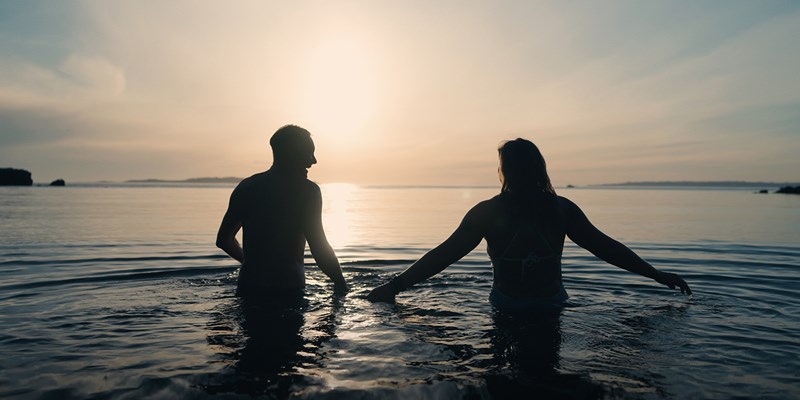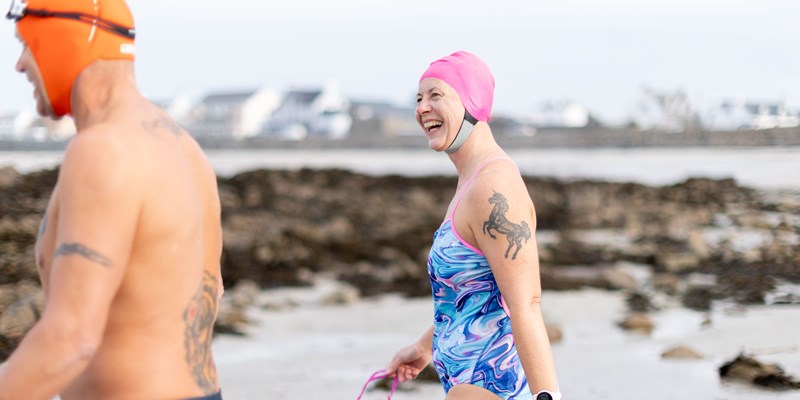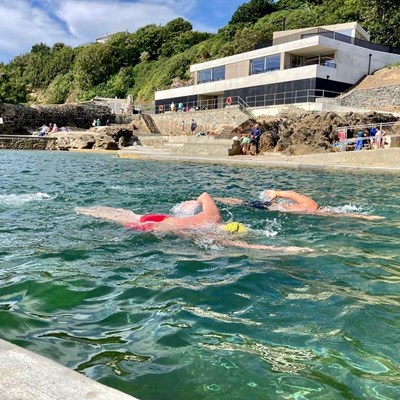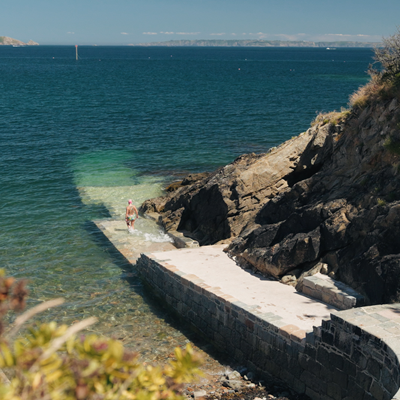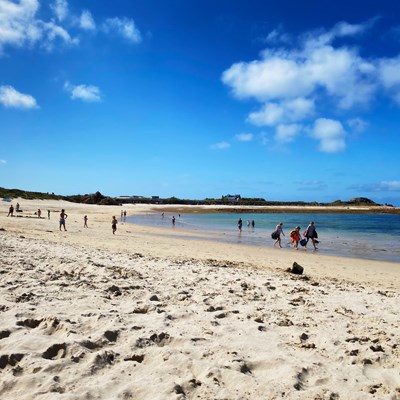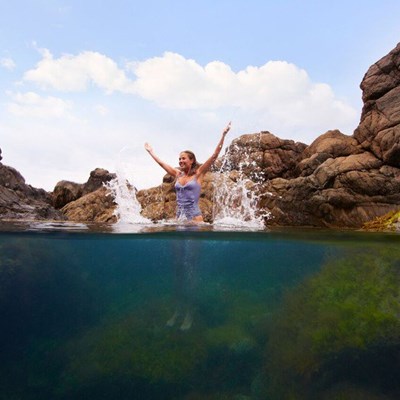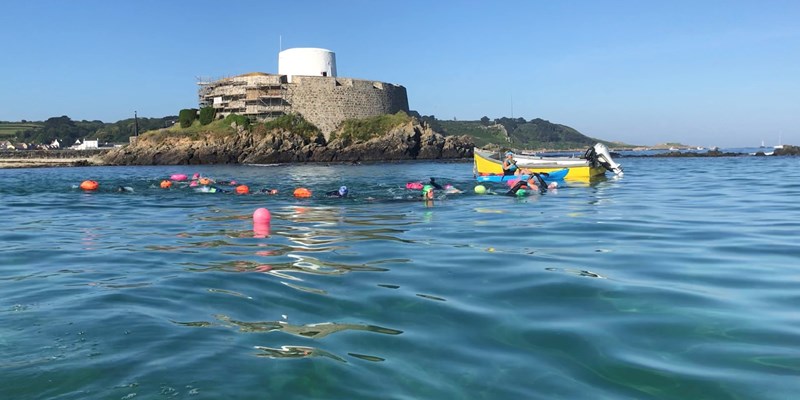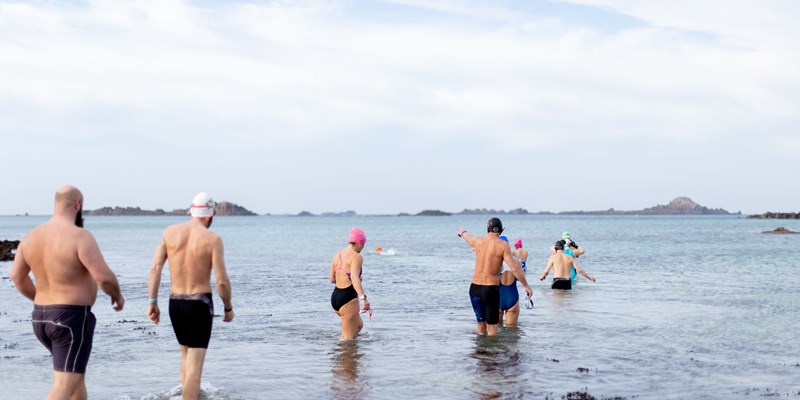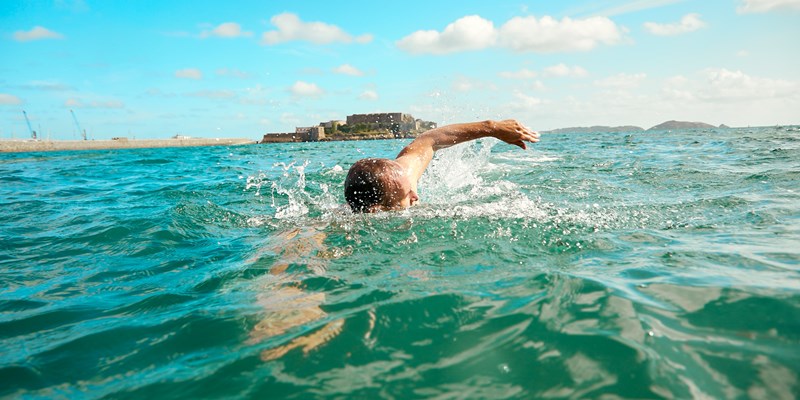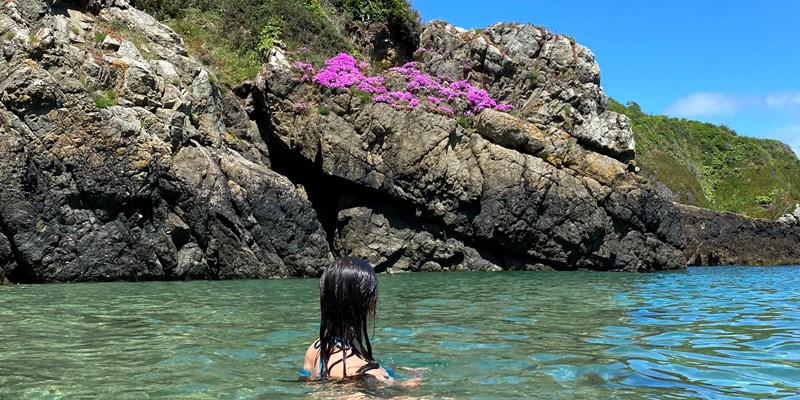Wild swimming is becoming an increasingly popular pastime, one which locals on The Islands of Guernsey have been enjoying for decades. Our beaches and bays make the perfect backdrop for an invigorating swim in the sea, and let you see our Islands from a new perspective.
If you’re just starting on your wild swimming adventure, or want to give it a go on your next trip to Guernsey, we've collated this guide with everything you need to know before you take the plunge. From the best beaches on our Islands for beginner sea swimming to tips that help make sure you are having fun and staying safe at the same time, this guide should help you get started with an activity that many people find themselves coming back to time and time again.
Why go wild swimming? What are the benefits?
The first question that many people ask when wild swimming is mentioned is: why? We all love going for a paddle in the summer to cool off after a day on the beach, but why would anyone want to dive into the chilly sea in the middle of March or in the cool winter months?
There are many benefits to wild swimming, with proclaimed health benefits such as a boosted immune system and dopamine levels and proven benefits including a release of endorphins that gives you a rush of happiness that lasts all day. Those taking part in outdoor swimming regularly report lowered stress levels and increased clarity of mind, particularly as the cold water and the need to focus on keeping swimming can help quiet an anxious mind.
It's unsurprising that with these benefits, so many people have taken to cold water swimming in recent years.
What do I need to bring?
Our local ambassador, Jayne Packham, is a keen wild swimming enthusiast and has created a list of all of her sea swimming essentials:
- Something to keep your head warm. This is to ensure that your body doesn’t lose too much heat - we suggest a woolly hat.
- Goggles to see through. The sea surrounding our Islands is extremely clear, so wearing goggles will allow you to see the huge variety of marine life that live in our waters. It’s also important to make sure that you can look out for other people in the water, whether that be other swimmers, surfers, paddleboarders, kayakers or anyone else. We are lucky to have so many different water activities available to us, but it is important to see and be seen!
- On the topic of respecting other sea users, it’s always wise to wear something to make you visible. This could be a brightly coloured swimming cap or a Swim Buoy, an inflatable ring worn around the waist when swimming.
- Your towel - drying off quickly when you get out is essential to make sure you warm up.
- A warm drink in a flask, or you can find a nearby kiosk, to refuel and warm up after your swim.
Check out more of Jayne's personal recommendations and her favourite bays on the Island here.
Where are the best swimming spots for beginners?
We have a huge range of beaches, bays and coves on The Islands of Guernsey, all of which have their own unique charms - it can be hard to know where to begin. Here are some of the best and safest beaches for wild swimming beginners.
The safest place to swim on The Islands of Guernsey is, without a doubt, La Vallette Bathing Pools. A group of saltwater pools in St Peter Port constantly topped up by the sea, here is where you can experience wild swimming in a safe and contained environment. The Bathing Pools have recently been renovated, with new changing rooms and a cafe just above the pools to warm up with a tea or coffee and a piece of cake after your swim.
Moulin Huet is one of the most popular beaches for swimming on our Islands. You can cater your swim to your ability; there is a steady entry into the water and you can either stick close to the shore or venture slightly further out. As you make your way to the beach, be sure to look out for the Renoir Trail - a walking trail you can follow depicting some of the views painted by renowned painter, Pierre-Auguste Renoir, who spent a few months on Guernsey in 1883 and painted landscapes of the stunning views over Moulin Huet.
Vazon Bay is a local favourite beach, especially with surfers, as the waves here are some of the best. Vazon is perfect for the whole family to swim at during calm weather as it is a very long, sandy beach, meaning you don't have to wade out very far to be able to swim for a long time and can keep close to the shore. Just be sure to be on the lookout for surfers and paddle boarders, especially if you find yourself between the circular ‘flags’ painted on the sea wall, as this is the designated surfing area. There are changing rooms next to the slipway. Vistas Beach Cafe is at one end of the beach and Richmond Beach Kiosk is at the other for a hot drink and lunch (or a Guernsey ice cream) after your swim.
Cobo Bay is possibly the most popular beach on Guernsey, filled with families and groups of friends sitting on the sand or swimming in the sea. Again, this beach is long so you can follow the shoreline along the bay without having to swim too far out to sea. There’s also Mim’s Kiosk, a classic beach kiosk, or Cobo Tearooms, a tearoom serving homemade cakes and coffee, nearby to rest with some food and a drink afterwards. Just remember to be cautious of other people whilst you’re swimming as it does get quite crowded, especially in the height of summer.
Home to the Beach House at Pembroke, another smaller kiosk and the only public beach wheelchairs on Guernsey, Pembroke and L’Ancresse bays are both extremely accessible beaches for swimming. Enter the beach from either slipway and walk down to the shallow water, where you can swim within the bays, or venture further out if you’re feeling daring. These beaches are best for swimming at high tide, as it can be quite a trek to get down to the water at low tide.
Port Soif is a sandy, sheltered horseshoe beach that is perfect for swimming safely at high tide. Take a walk along the coastal path before cooling off in the sea, grabbing a warm drink and an ice cream or a homemade snack from Surfside Kiosk once your swim is done.
Just along the coastal path from Port Soif is Portifer, a secluded cove with shallow waters that are great to swim in at high tide. It isn’t recommended to swim here at low tide, as there are some rocky patches to look out for when the water gets too low. Experienced surfers also often prefer the swell here to Vazon, so be sure to keep yourself visible as you’re swimming here.
Saye Beach (pronounced Soy Beach) is a curved bay in Alderney perfect for swimming. The rocky headlands on either side create a lot of shelter and this beach is not too busy, giving you privacy whilst you swim. You may also get the chance to see the resident Grey Seal!
The Venus Pool in the South of Little Sark is a natural swimming pool hidden in the rocks. It is best visited within two hours on either side of low tide, and is a shallow and safe way for beginners to experience wild swimming, not to mention being a completely unique experience. Please be aware that you have to navigate a few rocks to reach the pool - so this isn't the most accessible location.
Shell Beach on Herm is a beach covered in tiny shells washed up from the Gulf Stream. The beach stretches for nearly three-quarters of a mile, giving plenty of space for swimming adjacent to the shore. There is also a well-stocked beach cafe that will supply you with everything you could need to spend the whole day on the beach. Please note that a lot of beach activities, such as kayaking and Stand Up Paddle Boarding, supplied by Outdoor Guernsey, take place out of Shell beach, so be aware of other sea users as you’re swimming and make sure to keep yourself visible to others.
Are there swim groups I can join as a beginner?
It’s always advisable to take a buddy with you when wild swimming, especially if you are new to the activity. On Guernsey, there are groups of wild swimmers who make plans to meet and swim together. They are always welcoming to new members, whether you intend to join them frequently or just as a one-off experience. It's important to note that anyone who wants to join a swim group needs to take responsibility for themselves and do their own risk assessment before getting in and to swim within their own abilities. Some of these groups include:
Mental Tentacles - a group of wild swimmers, including our local ambassador, Jayne, who meet to swim, socialise and make fun videos to post on social media.
Guernsey Swim Adventures - a group offering a variety of wild swimming breaks and adventures as well as more relaxed social swims at various locations around the Island. Visit their Facebook page for more details.
Guernsey Open Water Swimming - a Facebook group where locals arrange swimming meet-ups that are free for anyone to join.
Guernsey Swim All Seasons - another Facebook group where members can organise casual swims and meetups. This group is geared towards people wanting to start swimming all year round or to find a swimming buddy.
What is the best time of year to go wild swimming in Guernsey?
Wild swimming enthusiasts on The Islands of Guernsey tend to swim all year round, no matter the temperature or weather. It is becoming increasingly popular to get in the sea every day, with many people finding they look forward to the exercise and peace that they get on their swim.
That being said, it is recommended to begin getting in the sea in the warmer months if you are just starting out on your wild swimming adventure. The water will be warmer, so your body won't have to acclimate so much as you get in, and, even if you do get cold in the sea, you will warm up faster once you get out if it is a warm summer's day.
How to stay safe while wild swimming and other helpful tips
The most important aspect of wild swimming is keeping safe. Here are some top tips for making sure that you are prepared and can stay safe while you’re having fun swimming.
- Make sure you check all the tides. Guernsey's tidal range of 33 feet is one of the largest in the world, completely transforming the coastline every six hours. It's important to keep an eye on the Guernsey Tide Table so that you don't get caught out. This website also provides a lot of information on local swim spots.
- Remember that the currents can get strong in some places because of the tides, so keep an eye on how far away from the shore you are.
- Make sure that you are warm before and after your swim. Bring warm clothing (lots of layers are best) and a hot drink with you. A woolly hat is recommended, as you lose most of your body heat through your head.
- Dry off quickly and get into your layers to warm up slowly. Don’t try to warm up quickly by taking a warm shower, as this could shock your body, instead warming up carefully and slowly.
- Get into the sea slowly and feet first to let your body adjust, taking care when you are entering the water to keep your breathing under control.
- Don’t stay in for too long. Even though wild swimming is a lot of fun, it can be tiring and you don’t want your body to get too cold.
- Take a buddy. It is always wise to take at least one other person with you when sea swimming. If there is no one to go with you, make sure that someone knows which beach you are heading to and how long you intend to be out - safety first!
- Check the weather before you get in. Swimming in a storm or if there is low visibility is not advised even for the most experienced wild swimmers. Guernsey Weather Fox is a good site to check when you’re here.
- Be seen and constantly be looking. We’ve mentioned it a few times already, but it is important to make sure that you are vigilant and keep an eye out on your surroundings and that you can be seen by other people using our waters. A brightly coloured swimming cap or a Swim Buoy are good ways to ensure you are visible.
- Avoid rocky promontories and stick to sandy bays with easy access in and out of the sea.
- Have fun! Sea swimming is meant to be done for the enjoyment of it, so make sure you take a moment to take in the scenery around you and enjoy what you’re doing.
Find out more about Wild Swimming on our Islands here.



